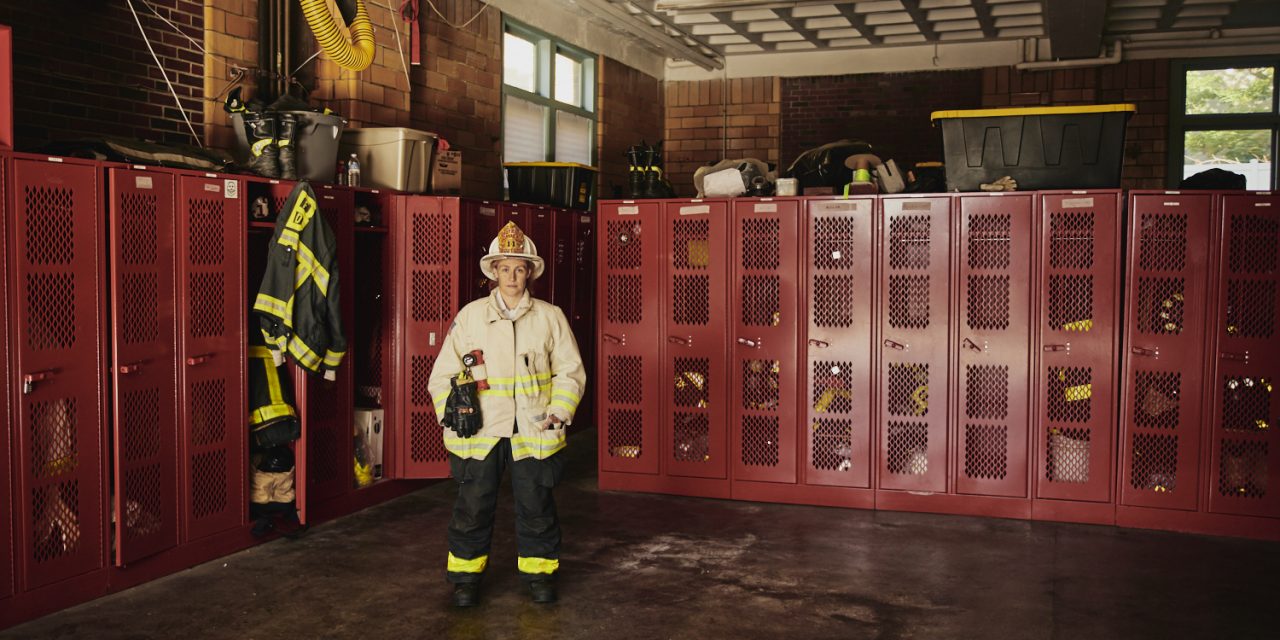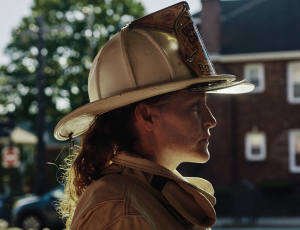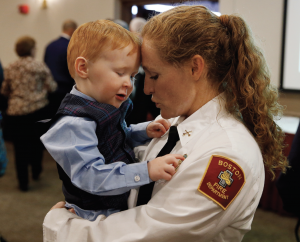
Hail To The Chief

– Firefighting is in the blood of the Mcdevitts. and now the family can claim the first female district fire chief in the 342-year history of the Boston Fire Department. –
A three-story brick building on Chestnut Hill Avenue, the Engine 29 firehouse primarily covers the Allston and Brighton neighborhoods of Boston. Inside, when District Fire Chief Deanna McDevitt ’99 is on duty and not out on a call, she spends hours at her desk thinking about and preparing for emergencies.
“I try to read, study, and learn from other incidents, whether they’re in Boston or across the country,” says McDevitt. “At an emergency, it can be stressful and overwhelming. You can lose what we call ‘situational awareness’ and get tunnel vision. So I prep and run through scenarios in my head beforehand. That way, when I am in an emergency situation, it’s not overwhelming and I can follow checklists in my head of what to do.”
 McDevitt, a fourth-generation Boston firefighter, was sworn in as a member of the fire department in 2008. In November 2019, she was promoted to district fire chief, the first woman ever to hold the position in Boston. Her father retired as a deputy chief of special operations in 2014, after more than 40 years of service. Her brother is currently a Boston firefighter, and her sister is a Boston police officer. Her grandfathers on both sides were Boston firefighters as was one great-grandfather.
McDevitt, a fourth-generation Boston firefighter, was sworn in as a member of the fire department in 2008. In November 2019, she was promoted to district fire chief, the first woman ever to hold the position in Boston. Her father retired as a deputy chief of special operations in 2014, after more than 40 years of service. Her brother is currently a Boston firefighter, and her sister is a Boston police officer. Her grandfathers on both sides were Boston firefighters as was one great-grandfather.
Despite this public service legacy, when McDevitt headed to Yale University, where she played ice hockey, she was not thinking about a career in firefighting. Her goal was to attend medical school after teaching for a few years at a private school. So after graduation, she began teaching chemistry and algebra at Kimball Union Academy. She also coached girls’ soccer, hockey, and lacrosse.
While teaching, she “was considering if I still wanted to pursue a medical career,” McDevitt says. “Then my brother joined the fire department in 2006. At his academy graduation, as I watched him walk across the stage and take the oath, I just thought, ‘Oh, this would be kind of neat to try.’”
She took the state’s civil service exam, which consists of a written exam and a physical abilities test. When she received the news that she would be part of the June 2008 class, she still wasn’t sure she wanted to be a firefighter, but she thought “it would be quite the experience to at least try it.”
For four months in 2008, she trained at the Boston Fire Department Training Academy. “I loved it from day one, honestly,” she says. “The teamwork aspect of it, the physical challenges involved—it just seemed like the perfect job for me. And to learn and share my academy experiences with my dad and my brother was just so unique.”
At the academy, she was one of two women. It is no secret that few women serve in the city’s fire department. A department review commissioned by the mayor’s office in 2018 revealed that out of a force of 1,500 firefighters, only 16 were women. The mayor has committed to carrying out all the recommendations in the report, including hiring more female firefighters.
“Everyone has to prove themselves, but when you are different—and being a woman makes you different—people are watching,” says McDevitt. “They want to see that you want to do the job, that you’re serious about it, and that you’re not looking for any special treatment. At the academy, I wanted to be clear that I didn’t want special treatment; I wanted to do this, and if there was something I couldn’t do, then I wanted to be reevaluated. There were definitely things that were more physically difficult for me, but everyone there was so supportive in teaching the techniques, and helping me find my strengths and improve on my weaknesses.”
New firefighters are assigned to a company, and McDevitt was assigned to Engine 3 in the South End. She spent five years there as a firefighter before she studied for the civil service exam and got her first promotion to lieutenant.
“Engine 3 was a great place to start,” she says. “The company has a good response area that includes downtown Boston, Dorchester, and South Boston. I got to see different aspects of firefighting, such as fighting a fire in a three-story wood-frame dwelling versus a high-rise building. I had excellent officers and senior firefighters who were always helping me learn and improve.”
In 2013, she was promoted to lieutenant, and then in 2016, to captain. “The transition to company officer was a challenge that I enjoyed,” she says. “I had worked for officers who were excellent leaders and taught me the importance of solid decision-making and consistency both on and off the fireground.” McDevitt worked several years as a lieutenant and then as a captain on Cambridge Street in Beacon Hill before returning to her hometown of South Boston as captain of Engine 39.
Today, as a district fire chief, McDevitt is assigned to District 11, overseeing the three firehouses and five fire companies in Brighton. She works two 24-hour shifts on an eight-day cycle.
As fire chief, she no longer goes with the company on many of the runs that she did as a firefighter, such as alarms sounding, vehicle accidents, and water leaks. But when Boston Fire Alarm receives a report of smoke or fire in a building, McDevitt says, “I respond with three engines, two trucks, and a rescue, and I am in charge of the fire operations from that point on.” She also responds to emergencies that require a chief officer to take over decision-making and control of the incident. Those could include alarms for carbon monoxide, natural gas leaks, or hazardous-material incidents.
At the scene, a fire chief stays out-
side, and the company goes in to figure out what is going on. The firefighters often have little or no information about the building they are about to enter. If it’s a minor problem, such as a malfunctioning appliance, they solve it and send everyone home. If it’s a small fire, they put it out. For bigger emergencies, the decisions of the fire chief are critical.

McDevitt holds her three-year-old son, Tommy, at
the ceremony marking her
promotion as the first
woman district fire chief
in the history of the
Boston Fire Department.
“What I love about my position now is problem solving and figuring out what is happening,” McDevitt says. “On the scene of an emergency, I’m figuring out who is there and where they are operating. It’s almost like coaching a team, figuring out who my players are.” McDevitt coached Milton’s girls’ varsity ice hockey for a few years while she was a firefighter. “Because I’m outside, I’m listening to the officers who go in the building tell me what’s going on. And then I’m figuring out how to solve the problem.”
McDevitt says the unknowns and the time pressure in an emergency can be challenging. “You only have a certain amount of time to make decisions. After an incident, I always examine should I have done this or should I have done that? What can I do better? Sometimes you need to look at your mistakes but then let go of them. It’s difficult, but then it also leads to improvement.”
At the time of this interview, last spring, the fire department was following new protocols because of covid-19, such as wearing personal protective equipment, taking temperatures twice a day, and not rotating firefighters between firehouses. One of the biggest losses was stopping firehouse meals, a beloved tradition worldwide when firefighters sit down and eat meals they cook for one another. “You would look forward to eating together, but in these times, we’re just trying to keep everyone safe,” says McDevitt.
Her husband, Thomas Carroll, is also a Boston firefighter at a different firehouse, and they have a three-year-old son. When she was pregnant, “they were so great about it. As soon as I was pregnant, until I had my baby, they gave me a desk job and then I went on maternity leave.”
And although she appreciated the desk job during her pregnancy, McDevitt couldn’t wait to get back to the firehouse and to a career that now seems like a natural fit. “My whole life feels like every-
thing—being an athlete, being on teams, training for hockey—all those things led me into having a good background to go into the firefighting field.”
Story by
Liz Matson
Photographs by
Tony Luong




